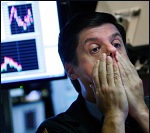By Pam Martens and Russ Martens: April 26, 2022
 When the U.S. Bureau of Labor Statistics released its Consumer Price Index (CPI) report on April 12, it showed that inflation had surged to the highest rate in 40 years, reaching 8.5 percent in March compared to the same month a year ago. The CPI report for February had shown a year-over-year increase of 7.9 percent – meaning that inflation had surged further in March and the Fed’s target of 2 percent inflation was getting further out of reach.
When the U.S. Bureau of Labor Statistics released its Consumer Price Index (CPI) report on April 12, it showed that inflation had surged to the highest rate in 40 years, reaching 8.5 percent in March compared to the same month a year ago. The CPI report for February had shown a year-over-year increase of 7.9 percent – meaning that inflation had surged further in March and the Fed’s target of 2 percent inflation was getting further out of reach.
While inflation has soared, supply bottlenecks from the pandemic and now Russia’s war in Ukraine are pushing down Gross Domestic Product (GDP) expectations. The highly-respected GDPNow model from the folks at the Atlanta Fed puts first quarter GDP in the U.S. at a tepid 1.3 percent. (That figure will be updated later today following the release of new home sales for March at 10 a.m.)
The Fed’s ability to slam the brakes on inflation with interest rate increases without crushing an already tepid GDP is a feat that markets do not see the Fed accomplishing. As of this morning, there is a rate inversion with the five-year U.S. Treasury note yielding 2.80 percent while going out five years longer in the 10-year U.S. Treasury note yields just 2.77 percent. Rate inversions mean the market does not have confidence that the Fed can raise interest rates aggressively without tipping the U.S. economy into recession.
The plight of the Ukrainian people in bombed-out cities and continued nuclear saber-rattling by Russian President Vladimir Putin and his military officials are causing investors around the globe to retrench. The tech-heavy Nasdaq composite, which had traded at more than 16,000 in November, closed yesterday at 13,004.85, a loss of more than 3,000 points in five months. As of yesterday’s close, the Nasdaq composite is down 16.88 percent year-to-date.
But the decline in the Nasdaq composite is masking the epic collapse in share prices of some of its individual components. As of yesterday’s close, on a year-to-date basis, Netflix has lost 65 percent of its market value; PayPal is down 53.45 percent; while Facebook (Meta Platforms) has plunged 44.4 percent. Numerous other components are down over 40 percent.
The fact that even after two years and wide distribution of COVID-19 vaccines, the pandemic remains a serious threat is being accentuated by China’s lockdown of Shanghai – a city of 25 million people. The BBC reports that the Chinese government’s measures to contain the spread of COVID in Shanghai include: “…placing electronic alarms on doors to prevent those with the virus from leaving and forcibly evacuating residents to allow their homes to be disinfected” as well as ordering “all infected patients and their close contacts to be transferred to government-run centralized quarantine.”
The Shanghai Composite stock market index closed today at 2,886.43 down 20.7 percent year-to-date.
All of this negative sentiment is having a chilling impact on the willingness of new companies to go public. Bloomberg News reported the following on March 26:
“About $65 billion has been raised via IPOs around the world in 2022, down 70% from $219 billion in the first three months of last year, according to data compiled by Bloomberg. That puts the global market on track for the lowest quarterly proceeds since the onset of the coronavirus pandemic in 2020.”
A shrinkage in investment banking fees is not, however, the biggest cloud on the horizon for Wall Street’s megabanks. Their lack of transparency on everything from their exposure to derivatives, to commodities, to Russian stocks is casting a pall over the shares of the megabanks.
The largest megabank on Wall Street is JPMorgan Chase. As of yesterday’s close, it has lost 19.94 percent of its market value year-to-date. That translates into a market cap loss of $92.85 billion.

